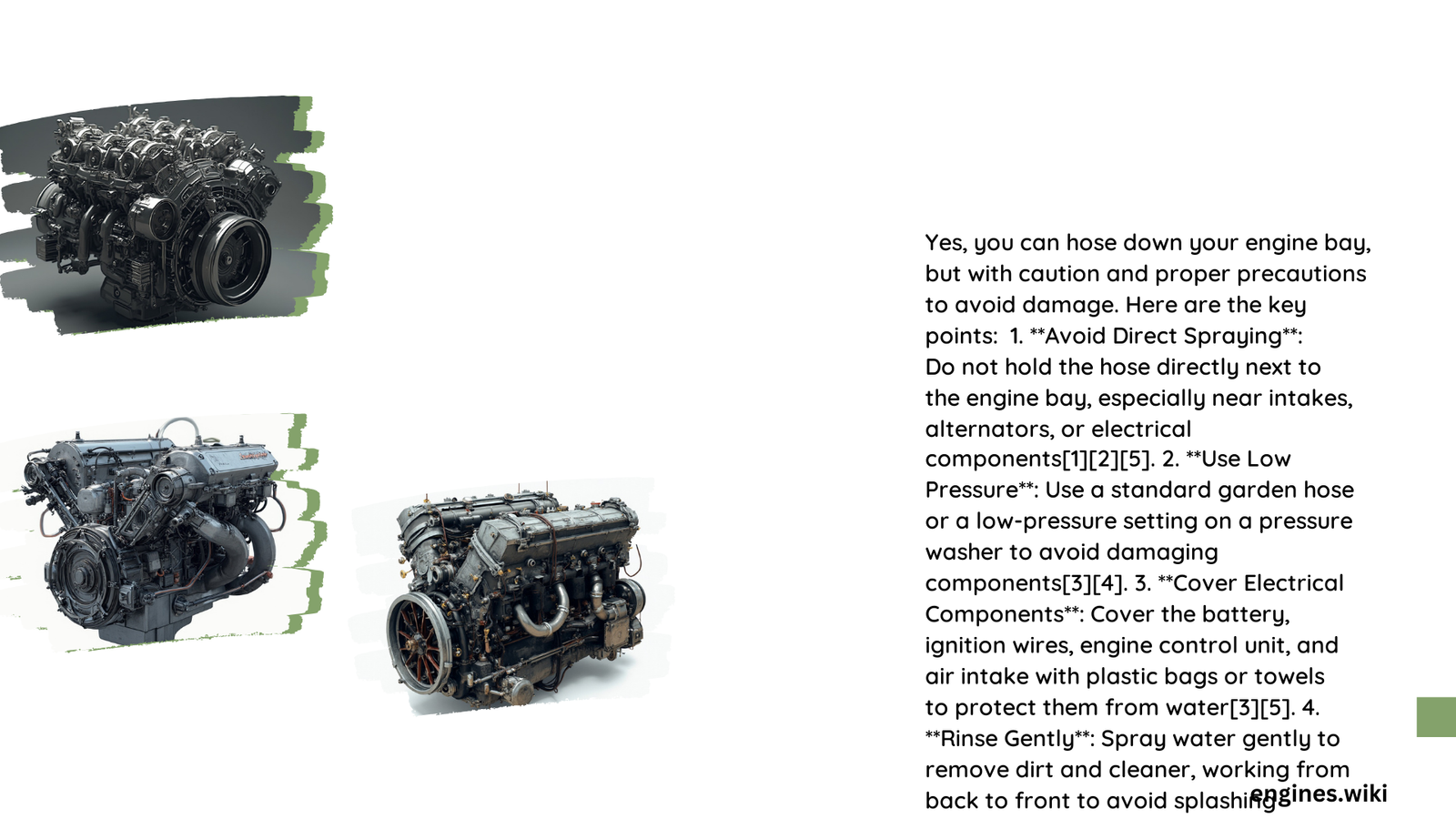Hosing down your engine bay can be a safe and effective way to clean it, but it requires careful preparation and execution. This process involves using water to remove dirt, grime, and oil buildup from the engine compartment. However, it’s crucial to take proper precautions to protect sensitive electrical components and prevent water damage. With the right techniques and safety measures, you can successfully clean your engine bay using a hose.
What Are the Safety Precautions Before Hosing Down an Engine Bay?
Before you start hosing down your engine bay, it’s essential to take the following safety precautions:
- Cool Engine: Ensure the engine is completely cool to avoid thermal shock. Wait at least 30 minutes after the car has been running.
- Protect Electrical Components: Cover all electrical parts such as the alternator, distributor, and exposed wiring with plastic bags and tape.
- Disconnect Battery: Remove the negative terminal of the battery or take out the battery entirely.
- Avoid High Pressure: Use a garden hose with a regular nozzle instead of a pressure washer.
- Prepare Cleaning Supplies: Gather microfiber towels, soft-bristle brushes, and engine-safe degreaser.
How to Safely Hose Down Your Engine Bay?

Follow these steps to safely hose down your engine bay:
- Initial Rinse: Use a gentle stream of water to remove loose dirt and debris.
- Apply Degreaser: Coat the engine bay with a non-corrosive degreaser designed for engines.
- Agitate: Use a soft-bristle brush to work the degreaser into stubborn stains.
- Thorough Rinse: Rinse the engine bay completely, avoiding high pressure around sensitive areas.
- Dry the Engine: Use clean microfiber cloths or compressed air to dry the engine thoroughly.
What Are the Most Vulnerable Engine Components to Water Damage?
When hosing down your engine bay, pay special attention to these vulnerable components:
- Alternator
- Distributor
- Air Intake
- Battery and Battery Terminals
- Exposed Wiring and Sensors
Protect these parts by covering them with plastic bags and securing with tape before cleaning.
How Often Should You Clean Your Engine Bay?
Regular maintenance of your engine bay is important for your vehicle’s health. Here’s a guideline for cleaning frequency:
| Driving Conditions | Recommended Cleaning Frequency |
|---|---|
| Normal | Every 6 months |
| Dusty/Dirty Areas | Every 3-4 months |
| Off-road Use | After each off-road trip |
What Are the Best Cleaning Agents for Engine Bay Cleaning?
Choosing the right cleaning agents is crucial for effective and safe engine bay cleaning:
- Engine Degreaser: Use a non-corrosive degreaser specifically designed for engine bays.
- All-Purpose Cleaner: For light cleaning, a mild all-purpose cleaner can be effective.
- Avoid Harsh Chemicals: Stay away from acidic or highly alkaline cleaners that can damage engine components.
What Tools Are Needed for Engine Bay Cleaning?
To properly clean your engine bay, you’ll need the following tools:
- Garden hose with a regular nozzle
- Microfiber towels
- Plastic bags and tape
- Soft-bristle brushes
- Engine degreaser
- Compressed air (optional, for drying)
What Are the Pros and Cons of DIY vs Professional Engine Bay Cleaning?
Consider these factors when deciding between DIY and professional engine bay cleaning:
DIY Engine Bay Cleaning
Pros:
– Cost-effective
– Can be done on your schedule
– Helps you become familiar with your engine
Cons:
– Time-consuming
– Risk of damaging components if done incorrectly
– May not be as thorough as professional cleaning
Professional Engine Bay Cleaning
Pros:
– Thorough and efficient cleaning
– Reduced risk of damage to engine components
– Time-saving for car owners
Cons:
– More expensive than DIY methods
– May need to schedule in advance
– Less hands-on experience with your vehicle
What Are the Best Weather Conditions for Engine Bay Cleaning?
Choosing the right weather conditions can make your engine bay cleaning more effective:
- Temperature: Warm days are ideal (60-80°F / 15-27°C)
- Humidity: Low humidity helps with faster drying
- Wind: A gentle breeze can aid in drying
- Avoid: Rainy or extremely hot days
How Can You Maintain a Clean Engine Bay Between Washes?
To keep your engine bay clean between major cleaning sessions:
- Regular Inspections: Check for oil leaks or buildup weekly.
- Spot Cleaning: Address small spills or stains immediately.
- Use Engine Covers: If available, use engine covers to reduce dirt accumulation.
- Avoid Overfilling Fluids: Prevent spills by not overfilling engine fluids.
By following these guidelines, you can safely and effectively hose down your engine bay, keeping it clean and well-maintained. Remember to always prioritize safety and take necessary precautions to protect sensitive components during the cleaning process.
References:
1. AutoZone – How to Clean Your Engine Bay
2. Shine Armor – How To Clean Your Car’s Engine Bay: 8 Dos and Don’ts To Observe
3. Chemical Guys – How to Clean Your Car Engine Bay
